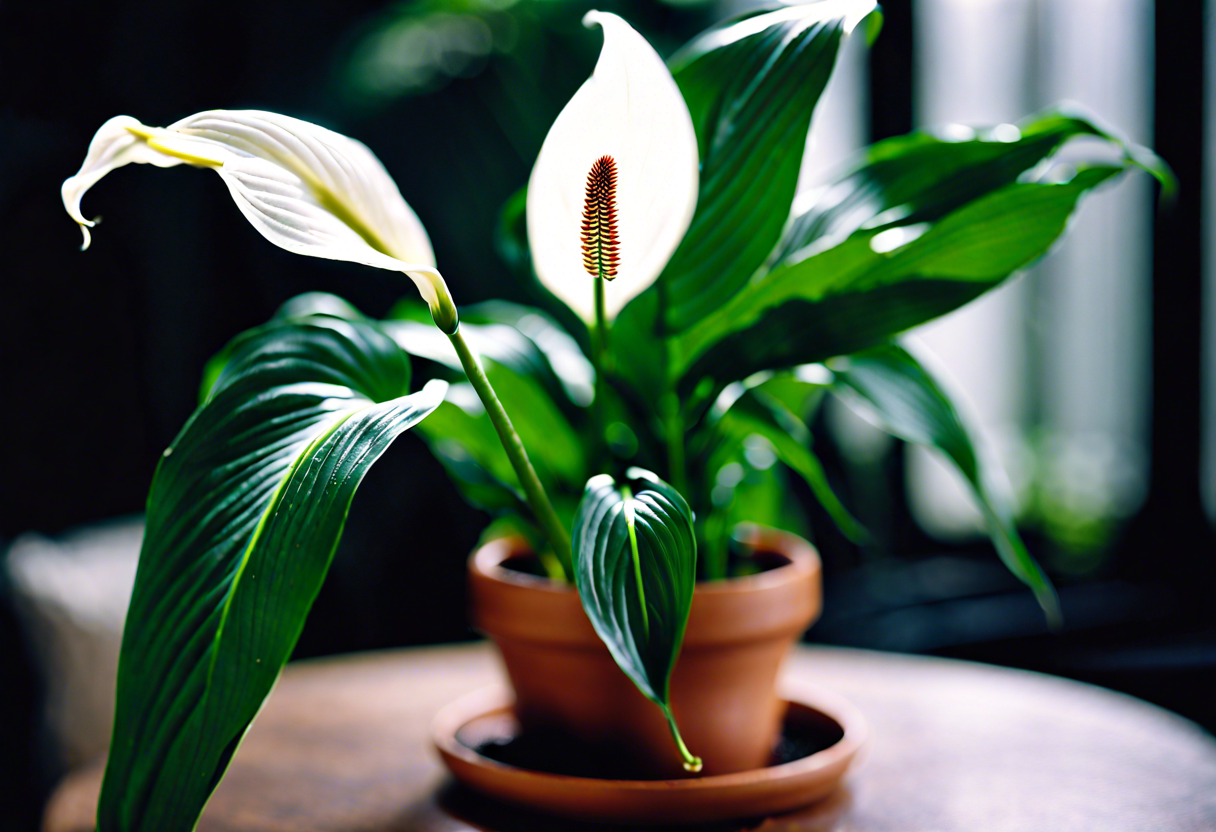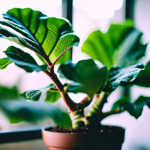Ideal Growing Conditions for Peace Lily (Spathiphyllum)
Peace lilies, also known as Spathiphyllum, are popular indoor plants due to their elegant white flowers and lush green foliage. To ensure the health and vitality of your peace lilies, it’s essential to provide them with the ideal growing conditions. Here’s a care guide to help you create the perfect environment for your peace lilies:
Light: Peace lilies thrive in indirect, bright, or medium light conditions. They can tolerate low light but may not flower as abundantly. Avoid exposing them to direct sunlight as it can scorch their leaves. Placing them near a north or east-facing window is ideal.
Temperature: Peace lilies prefer temperatures between 65 to 80 degrees Fahrenheit (18 to 27 degrees Celsius). They can tolerate slightly cooler temperatures but may not grow as quickly. Keep them away from drafts or extreme temperature changes, such as near windows or heating vents.
Humidity: These tropical plants love high humidity levels. To increase humidity, place a tray filled with water near the plant, or use a humidifier. Misting the leaves occasionally can also help, especially during dry winter months.
Soil: Peace lilies prefer a well-draining potting mix that retains some moisture. A mixture of peat moss, perlite, and compost works well. Avoid using heavy soil that may retain too much water, as it can lead to root rot.
Watering: Proper watering is crucial for peace lilies. Keep the soil consistently moist but not waterlogged. Allow the top inch of the soil to dry between waterings. Overwatering can lead to root rot, while underwatering may cause the leaves to wilt. It’s essential to strike a balance.
Fertilizer: Feed your peace lilies with a balanced water-soluble fertilizer every two to four months during the growing season (spring and summer). Avoid overfertilizing, as it can burn the plant’s roots. During the dormant period (fall and winter), reduce the frequency of fertilization.
Repotting: Peace lilies prefer slightly crowded roots, so repotting is usually required every two to three years. Choose a pot that is only slightly larger than the previous one, as excessive space may lead to overwatering. Use fresh potting mix and handle the roots with care.
Pruning: Remove any yellow or brown leaves to maintain the plant’s appearance and prevent disease. Trim spent flowers to encourage new blooms. Wipe down the leaves regularly with a damp cloth to remove dust and promote healthy growth.
By following these care guidelines, you can provide the ideal growing conditions for your peace lilies. With proper care, they will reward you with their stunning blooms and vibrant foliage, adding beauty and serenity to your indoor space.
Watering Tips for Peace Lily (Spathiphyllum) Plants
Proper watering is essential for the health and vitality of Peace Lily plants. While they are known for their ability to tolerate some degree of neglect, it is still important to provide them with adequate moisture to ensure optimal growth. Here are some watering tips to keep your Peace Lily thriving:
1. Monitor the soil moisture: Peace Lily plants prefer to be kept evenly moist, but not overly wet. Before watering, always check the moisture level of the soil by inserting your finger about an inch deep. If it feels dry at this depth, it’s time to water the plant.
2. Use room temperature water: When it comes to watering your Peace Lily, it is best to use room temperature water. Avoid using cold water, as it can shock the plant’s roots and lead to stress. Let tap water sit overnight to allow any chlorine to dissipate before using it to water your plant.
3. Water thoroughly: When watering your Peace Lily, make sure to water it thoroughly. This means watering until water starts to flow out of the drainage holes at the bottom of the pot. This helps ensure that the entire root ball gets hydrated.
4. Proper drainage: Good drainage is crucial for Peace Lily plants. Make sure the pot has drainage holes to allow excess water to escape. If using a decorative pot without drainage, consider using a separate container with drainage and placing it inside the decorative pot.
5. Avoid overwatering: While Peace Lilies like to be kept evenly moist, overwatering can lead to root rot and other problems. It’s important not to let the plant sit in water for extended periods. Always discard any excess water that collects in the saucer or tray after watering.
6. Adjust watering frequency: The frequency of watering will depend on various factors such as the size of the pot, the temperature, and the humidity levels in your home. As a general guideline, water your Peace Lily when the top inch of soil feels slightly dry to the touch.
7. Mist the leaves: Peace Lily plants appreciate a humid environment, so misting the leaves occasionally can help increase humidity levels. This is especially beneficial during dry winter months when indoor humidity tends to be lower.
8. Consider using a moisture meter: If you’re unsure about when to water your Peace Lily, you can use a moisture meter to accurately measure the moisture level of the soil. This can help prevent overwatering or underwatering and promote healthier plant growth.
By following these watering tips, you can ensure that your Peace Lily (Spathiphyllum) plants receive the right amount of water and thrive in your indoor space. Remember to observe your plant closely and adjust your watering routine based on its specific needs, as different environments and situations may require slight variations in watering frequency.
Watering Tips for Peace Lily (Spathiphyllum) Plants
Proper watering is crucial for the health and vitality of your Peace Lily (Spathiphyllum) plants. These lush and elegant beauties require a consistent and well-balanced watering routine to thrive. By following these watering tips, you can ensure your Peace Lily receives the moisture it needs while avoiding common watering mistakes.
1. Watering Frequency: Peace Lily plants prefer slightly moist soil, but they are susceptible to root rot if overwatered. A good rule of thumb is to water your Peace Lily when the top inch of the soil feels dry to the touch. This usually translates to watering every 1 to 2 weeks, depending on the climate and humidity levels.
2. Watering Method: When watering your Peace Lily, it’s advisable to use room temperature water. Avoid using chlorinated water straight from the tap, as the chlorine can harm the plant. You can either let the water sit out for 24 hours to let the chlorine evaporate or use filtered water.
3. Proper Drainage: Ensure that the pot your Peace Lily is in has drainage holes at the bottom to allow excess water to escape. Sitting in waterlogged soil can lead to root rot and other fungal diseases. Always empty the saucer or tray underneath the pot after watering to prevent water from pooling.
4. Soil Moisture: Aim for moist, but not soggy, soil. Overwatering can suffocate the roots and cause them to rot. Conversely, underwatering can lead to wilting and yellowing leaves. Insert your finger about an inch into the soil to check for moisture. If it feels dry, it’s time to water.
5. Mist to Increase Humidity: Peace Lily plants thrive in high humidity environments. Misting the leaves regularly can help increase humidity levels, especially during dry seasons or in air-conditioned rooms. You can also place the plant on a tray filled with water and pebbles to create a humid microclimate.
6. Avoid Standing Water: If your Peace Lily is grown in a pot without drainage holes or is placed in a decorative container, be cautious not to let excess water accumulate at the bottom. This can lead to root rot and other moisture-related issues.
Remember, every plant has unique watering requirements, and it’s essential to observe your Peace Lily carefully. Adjust your watering routine based on the plant’s response and the environment it’s in.
By following these watering tips, you can provide your Peace Lily (Spathiphyllum) plants with the ideal moisture levels they need to flourish, keeping their glossy green leaves and white blossoms looking their best.
Common Pests and Diseases Affecting Peace Lily (Spathiphyllum) Plants
Peace lilies, also known as Spathiphyllum, are popular houseplants that are cherished for their attractive foliage and beautiful white flowers. These plants are generally low-maintenance, but like any other plant, they can be susceptible to pests and diseases. Understanding the common issues that can affect peace lilies is crucial for keeping them healthy and thriving. Here are some of the most common pests and diseases that you should be aware of:
Pests:
-
Spider Mites: Spider mites are tiny pests that can cause significant damage to peace lily plants. They feed on the plant’s sap, leading to leaf discoloration, webbing, and stunted growth. To control spider mites, regularly inspect the undersides of the leaves and use a mild insecticidal soap or neem oil to treat infested plants.
-
Mealybugs: Mealybugs are soft-bodied insects that are commonly found on the leaves and stems of peace lilies. They appear as tiny, white, cotton-like clusters. Mealybugs feed on the plant’s sap, causing yellowing leaves and stunted growth. To get rid of mealybugs, manually remove them with a cotton swab dipped in rubbing alcohol or treat the plant with insecticidal soap.
-
Aphids: Aphids are small, pear-shaped insects that can gather on the new growth of peace lily plants. They suck the sap from the leaves and excrete a sticky substance called honeydew, which can attract ants and promote the growth of sooty mold. Use a strong stream of water or insecticidal soap to control aphid infestations.
Diseases:
-
Root Rot: Overwatering or poorly drained soil can lead to root rot in peace lilies. This fungal disease causes the roots to become mushy and discolored, resulting in wilting, yellowing leaves, and plant decline. To prevent root rot, ensure proper drainage and allow the soil to dry between waterings. If root rot occurs, trim off the affected roots and repot the plant in fresh, well-draining soil.
-
Leaf Spot: Leaf spot is a fungal disease that manifests as small, dark spots on the leaves of peace lilies. It can cause leaf yellowing, browning, and eventually, leaf drop. To control leaf spot, remove and destroy infected leaves, improve air circulation around the plant, and avoid overhead watering.
-
Powdery Mildew: Powdery mildew appears as a powdery white coating on the leaves of peace lilies. It thrives in high humidity and can cause distorted growth and yellowing leaves. To treat powdery mildew, improve air circulation, reduce humidity levels, and apply a fungicidal spray if necessary.
Regularly inspecting your peace lily plants, practicing good hygiene, and providing optimal growing conditions can help prevent and manage pest and disease issues. Remember to isolate infected plants to prevent the spread of pests and diseases to other plants in your collection. With proper care, your peace lilies will continue to thrive and bring beauty to your indoor space.
Propagation Techniques for Expanding Your Peace Lily (Spathiphyllum) Collection
Are you a plant enthusiast looking to expand your collection of Peace Lily plants? Propagation is a great way to do just that! With a few simple techniques, you can easily create new plants from an existing Peace Lily. In this guide, we will explore different methods of propagating Peace Lily (Spathiphyllum) plants, so you can successfully grow your collection.
1. Division
Division is one of the most popular methods of propagating Peace Lily plants. Follow these steps to divide your plant:
- Start by removing the Peace Lily from its pot and gently shaking off the excess soil.
- Inspect the plant and identify any natural divisions or multiple clumps of growth.
- Using a sharp, clean knife or shears, carefully separate the clumps, ensuring that each division has enough roots attached.
- Plant each division in a separate pot, filled with well-draining potting soil.
- Water the newly potted divisions thoroughly and place them in a warm, bright location.
2. Stem Cuttings
Another effective way to propagate Peace Lily plants is through stem cuttings. Here’s how:
- Select a healthy, mature stem from the Peace Lily.
- Using a sharp, sterile knife or scissors, cut a section of the stem that is around 4-6 inches long.
- Remove any lower leaves or flowers from the cutting, leaving a few at the top.
- Dip the cut end of the stem in a rooting hormone powder to aid in the development of roots.
- Plant the cutting in a small pot filled with well-draining soil or a mixture of peat and perlite.
- Place the potted cutting in a warm and humid environment, away from direct sunlight.
- Keep the soil consistently moist but not waterlogged.
- After a few weeks, roots should begin to develop, and you can then transfer the cutting to a larger pot.
3. Leaf Cuttings
Leaf cuttings can also be used to propagate Peace Lily (Spathiphyllum) plants. Follow these steps:
- Select a healthy, mature leaf from the Peace Lily.
- Cut the leaf into sections, making sure each section has a part of the leaf vein.
- Place the leaf sections in a tray or shallow container filled with a mixture of moist peat and perlite.
- Keep the tray covered with a plastic bag or a clear plastic dome to maintain high humidity.
- Place the tray in a warm spot, out of direct sunlight.
- Ensure that the medium remains moist but not waterlogged.
- After a few weeks, small plantlets should begin to emerge from the leaf sections.
- Once the plantlets have developed roots and leaves, you can transplant them into individual pots.
By using these propagation techniques, you can easily expand your Peace Lily (Spathiphyllum) collection and enjoy the beauty of these elegant plants throughout your home. Remember to provide proper care and nurturing to your newly propagated plants, and soon you’ll have a thriving collection to admire and share.
Conclusion
Taking proper care of your Peace Lily (Spathiphyllum) plants is essential to ensure their health and longevity. By providing ideal growing conditions, proper watering, fertilizing techniques, and knowing how to handle common pests and diseases, you can create an environment in which your Peace Lily thrives. Additionally, learning about propagation methods allows you to expand your collection and share the beauty of these plants with others.
Creating ideal growing conditions is key to the success of your Peace Lily. These plants prefer bright, indirect light, making them perfect for indoor spaces. It is best to keep them away from direct sunlight, as this can scorch their leaves. Maintaining a temperature range of 65-80°F (18-27°C) is ideal, and they thrive in high humidity environments. Placing your Peace Lily near a humidifier or misting their leaves regularly can help achieve the humidity levels they require.
When it comes to watering your Peace Lily, it is important to strike a balance. Overwatering can cause root rot, while underwatering can lead to wilting and dryness. To determine when to water, check the moisture level of the soil by sticking your finger about an inch deep. If it feels dry, it’s time to water. Peace Lilies appreciate consistently moist soil but not sitting in water. Allow the top inch of soil to dry out between waterings, but never let the plant completely dry out.
Fertilizing your Peace Lily helps promote healthy growth and vibrant foliage. Use a balanced, water-soluble fertilizer during the growing season, usually spring and summer. Follow the instructions on the fertilizer package for the appropriate amount and frequency. It is crucial to avoid overfertilization, as this can burn the plant’s roots.
Despite their hardiness, Peace Lilies can still fall victim to pests and diseases. Common pests include spider mites and mealybugs. Regularly inspect your plants for signs of infestation, such as sticky leaves, webbing, or tiny insects. If you notice any pests, treat them immediately with organic insecticidal soaps or neem oil. Diseases such as root rot can be avoided by ensuring proper drainage and not overwatering. Monitoring the moisture levels and inspecting the roots periodically can help identify and prevent such issues.
If you want to expand your Peace Lily collection or share these beautiful plants with others, propagation methods come in handy. One method is division, which involves carefully separating the rhizomes and replanting them in separate pots. Another option is propagating through stem cuttings. Select a healthy stem, cut just below a node, and place it in water or a well-draining potting mix until roots form.
Taking care of your Peace Lily (Spathiphyllum) plants involves providing ideal growing conditions, proper watering techniques, and proper fertilizing. To keep your plants strong and healthy, it’s essential to be vigilant and address any pests or diseases promptly. Additionally, expanding your collection through propagation methods allows you to enjoy the beauty of Peace Lilies throughout your home or share them with others. With these care tips in mind, you can create an environment where your Peace Lily thrives for years to come.


